Robert Ley
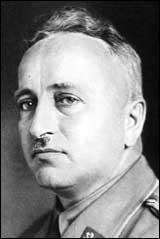
Robert Ley, the seventh of eleven children, was born on 15th February, 1890. When he was a child, his father got deeply into debt and tried to raise insurance money to repay it by setting fire to his farm.
Richard Evans has argued: "To judge from Ley's later autobiographical writings, the poverty and disgrace that ensued for the family after his father's conviction for arson left the boy with a permanent sense of social insecurity and resentment against the upper classes." (1)
Ley was a military aviator during the First World War but was shot down over France in 1917 and spent over two years as a prisoner of war. The incident left Ley with serious injuries, including damage to the frontal lobe of his brain. After the war Ley worked as a chemist but was sacked because of his serious drink problem. (2)
Ley joined the National Socialist German Workers Party (NSDAP) in 1925 and later that year became Gauleiter for Rhineland South. Ley became close to Gregor Strasser and his brother, Otto Strasser, who had established the Berliner Arbeiter Zeitung, a left-wing newspaper, that advocated world revolution. It also supported Lenin and the Bolshevik government in the Soviet Union.
In 1925 the Strasser brothers argued the the property of the former German royal houses should be expropriated. Adolf Hitler disagreed with this policy. At a NSDAP meeting in Hanover, Ley and Gottfried Feder were the only leading figures in the party who supported Hitler. When Feder protested in Hitler's name, Joseph Goebbels jumped to his feet: "In these circumstances I demand that the petty bourgeois Adolf Hitler be expelled from the National Party." (3)
After hearing Hitler speak on 12th July 1925, Goebbels changed his mind about the leader of the party: "Hitler begins to speak. What a voice. What gestures, what passion. Exactly what I had wanted from him. I can scarcely contain myself. My heart stands still. I hang on every word." (4) Goebbels apologised to Hitler about his earlier comments and he was later given a senior post in the Nazi Party. However, Hitler never forgot that it was Ley who supported him in his time of need. (5) Goebbels developed a dislike for Ley and described him as a "blockhead". (6) In 1928 Hitler appointed Ley as the Gauleiter of Cologne. He was elected to the Prussian Landtag and in 1930 to the Reichstag. (7) In the spring of 1932 he was sentenced to three months in prison for assaulting Otto Wels, the Chairman of the Social Democrat Party (SDP). (8) Soon after Adolf Hitler became chancellor in January 1933 he announced new elections. Hermann Goering called a meeting of important industrialists where he told them that the election would be the last in Germany for a very long time. He explained that Hitler "disapproved of trade unions and workers' interference in the freedom of owners and managers to run their concerns." (9) Thousands of members of the Social Democrat Party and trade union activists were arrested and sent to recently opened concentration camps. Left-wing election meetings were broken up by the Sturm Abteilung (SA) and several candidates were murdered. Newspapers that supported these political parties were closed down during the election. Although it was extremely difficult for the opposition parties to campaign properly, Hitler and the Nazi party still failed to win an overall victory in the election on 5th March, 1933. The Nazi Party received 43.9% of the vote and only 288 seats out of the available 647. The increase in the Nazi vote had mainly come from the Catholic rural areas who feared the possibility of an atheistic Communist government. Hitler proclaimed May Day, 1933, as a national holiday and arranged to celebrate it as it had never been celebrated before. Trade union leaders were flown to Berlin from all parts of Germany. Joseph Goebbels staged the greatest mass demonstration Germany had ever seen. Hitler told the workers' delegates: "You will see how untrue and unjust is the statement that the revolution is directed against the German workers." Later that day Hitler told a meeting of more than 100,000 workers that "reestablishing social peace in the world of labour" would soon begin. (10) The next day, Hitler ordered the Sturm Abteilung (SA) to destroy the trade union movement. Their headquarters throughout the country were occupied, union funds confiscated, the unions dissolved and the leaders arrested. Large numbers were sent to concentration camps. Within a few days 169 different trade unions were under Nazi control. (11) Hitler gave Robert Ley the task of forming the German Labour Front (DAF). Ley, in his first proclamation, stated: "Workers! Your institutions are sacred to us National Socialists. I myself am a poor peasant's son and understand poverty... I know the exploitation of anonymous capitalism. Workers! I swear to you, we will not only keep everything that exists, we will build up the protection and the rights of the workers still further." (12) Three weeks later Hitler decreed a law bringing an end to collective bargaining and providing that henceforth "labour trustees", appointed by him, would "regulate labour contracts" and maintain "labour peace". Since the decisions of the trustees were to be legally binding, the law, in effect, outlawed strikes. Ley promised "to restore absolute leadership to the natural leader of a factory - that is, the employer... Only the employer can decide." (13) The German Labour Front was the only union organization allowed in the Third Reich and had over 20 million members. Ley appointed twelve state officials whose job it was to regulate wages, conditions of work and labour contracts in each of their respective districts, and to maintain peace between workers and employers. (14) The DAF was "rendered totally docile and workers no longer had any voice in management". (15) The results of the elections to works councils suggest that the Labour Front representatives were not popular with the German workforce. As a result, no further elections were held after 1935. Some workers continued to resist fascism and in some sectors, such as metal and wood workers, railwaymen and seafarers maintained impressive illegal networks. (16) Strength Through Joy (KdF) was established as a subsidiary of the German Labour Front on 27th November, 1933. It was an attempt to organize workers' leisure time rather than allow them to organize it for themselves, and therefore enable leisure to serve the interests of the government. Ley claimed that "workers were to gain strength for their work by experiencing joy in their leisure". (17) The scheme has been described as "regimented leisure" and that Hitler deemed it "necessary to control not only the working hours but the leisure hours of the individual". (18) The scheme had been heavily influenced by the theories of the Belgian fascist, Henri de Man, who sought to fuse the theories of Karl Marx and Sigmund Freud. It also took some of the ideas behind the Italian Fascist Opera Nazionale Dopolavoro, the leisure and recreational organization, concentrating on sports and other outings for adults, that had been introduced by Benito Mussolini in 1925. (19) Albert Speer was a great supporter of Ley's plan to persuade factory owners to improve the workplace: "First we persuaded factory owners to modernize their offices and to have some flowers about. But we did not stop there. Lawn was to take the place of asphalt. What had been wasteland was to be turned into little parks where the workers could sit during breaks. We urged that window areas within factories be enlarged and workers' canteen set up... We provided educational movies and a counseling service to help businessmen on questions of illumination and ventilation... One and all devoted themselves to the cause of making some improvements in the workers' living conditions and moving closer to the ideal of a classless People's Community." (20) Since the late 19th century the Social Democrat Party (SDP) and the German trade unions had built sports grounds and hiking hostels. These were now taken over by the German Labour Front and used for its members. With these resources it was able to offer discounted leisure activities that were within the financial reach of many workers and their families. By 1934-35, over three million people were taking part in its physical education and gymnastics evenings, while many others took advantage of the cheap coaching it offered in tennis, golf, skiing, sailing and other upper-middle-class-sports. (21) Strength Through Joy promoted evening classes, amateur cultural activities, recitals and travelling art exhibitions. Plays were performed in factories and specially organized KdF concerts, featuring important classical conductors and soloists, such as Carl Bohm, Eugen Jochum and Wilhelm Furtwanger, played to German workers. (22) The KdF had its own ninety-piece symphony orchestra which continually toured the country and in 1938 over two and a half million people attended its concerts. One observer pointed out that the KdF "made available at bargain rates tickets to the theatre, the opera and concerts, thus making available more highbrow entertainment to the labouring man." (23) The success of the KdF brought Robert Ley into conflict with Joseph Goebbels. According to his biographer, Toby Thacker, Goebbels objected to the idea that the professional associations of German artists should be part of the Labour Front. (24) Goebbels held a meeting with Adolf Hitler and eventually he agreed that he should be free to organize all persons "belonging to the areas of activity under his jurisdiction". (25) The most popular aspect of Strength Through Joy was the provision of subsidized holidays. Large sections of the labour force were for the first time given the opportunity of holidaying away from home. The holidays ranged in price from a week in the Harz Mountains (28 marks), one week at the North Sea coast (35 marks) and a fortnight at Lake Constance (65 marks). As the average wage of an industrial worker was about 30 marks, it enabled a third of all workers to go on holiday. (26) The KdF set about building its own model resort on the Baltic island of Rügen. Construction began under the supervision of Albert Speer on 3rd May 1936. "The resort spanned eight kilometres of the Baltic shore, with six-story residence blocks interspersed with refectories and centred on a huge communal hall designed to accommodate all 20,000 of the resort's holidaymakers as they engaged in collective demonstration of enthusiasm for the regime and its policies. It was consciously designed for families, to make good the lack of facilities for them in other Strength Through Joy enterprises, and it was intended to be cheap enough for the ordinary worker to afford, at a price of no more than 20 Reichsmarks for a week's stay." (27) The better paid workers were able to go abroad. A tour of Italy cost 155 marks. Strength Through Joy commissioned the building of two 25,000-ton purpose-built ships and chartered ten others to handle ocean cruises. The Robert Ley could carry 1,600 passengers. It only had forty lavatories and 100 showers but 156 loudspeakers that relayed on-board propaganda. (28) The liner also included a gymnasium, a theatre and a swimming pool to ensure that participants engaged in regular healthy exercise and experienced serious cultural events. (29) These cruise liners sailed as far as the Norwegian fjords, Maderia, Libya, Finland, Bulgaria and Turkey. 180,000 Germans went on cruises in 1938 and the volume of tourism doubled. (30) In 1939 alone, 175,000 people went to Italy on organized trips, a good number of them travelling on cruise liners. (31) William L. Shirer, an American journalist went on a KdF cruise: "Though life abroad was organized by Nazi leaders to a point of excruciation, the German workers seemed to have a good time. And at bargain rates! A cruise to Maderia, for instance, cost only $25, including rail fare to and from the German port, and other jaunts were equally inexpensive... In winter special skiing excursions to the Bavarian Alps were organized at a cost of $11 a week, including car fare, room and board, rental of skis and lessons from a ski instructor." (32) The governments of other European countries took an interest in what the KdF was doing. The British ambassador in Berlin, Sir Neville Henderson, pointed out: "There are, in fact, many things in the Nazi organization and ideology, which we might study and adapt to our own use with great profit both to the health and happiness of our own nation and old democracy." (33) The German Labour Front deprived the workers of any bargaining mechanism. The employer, with the support of the Labour Front, was able to decide on the amount that the workforce were paid. A wage freeze was decreed in 1933 and was enforced by the Labour Front during the period that the Nazis were in power, despite rising costs of living. "The Labour Front had become a gigantic state prison from which workers had no way out." (34) There was little resistance to the policies of the Labour Front. In June 1936, there was a seventeen-minute stoppage at Rüsselsheim Opel Works by 262 workers protesting against a wage cut brought about by raw-material shortages. The leaders were immediately arrested and over 40 of the men were blacklisted. (35) These tactics appeared to work. In 1928 a total of 20,339,000 days were lost to strikes. After the formation of the Labour Front, there were no recorded strikes in Nazi Germany. In 1935 Robert Ley claimed that Germany was the first country in Europe to overcome the class struggle. (36) Although millions more had jobs, the share of all German workers in the national income fell from 56.9% in the depression year of 1932 to 53.6% in the boom year of 1938. At the same time income from capital and business rose from 17.4% of the national income for 26.6%. William L. Shirer, the author of The Rise and Fall of Nazi Germany (1959) states: "All the propagandists in the Third Reich from Hitler on down were accustomed to rant in their public speeches against the bourgeois and the capitalist and proclaim their solidarity with the worker. But... the official statistics... revealed that the much maligned capitalists, not the workers, benefited most from Nazi policies." (37) Robert Ley told the workers at the Siemens factory in Berlin: "We are all soldiers of labour, amongst whom some command and the others obey. Obedience and responsibility have to count amongst us again... We can't all be on the captain's bridge, because then there would be nobody to raise the sails and pull the ropes. No, we can't all do that, we've got to grasp the fact." (38) One historian has claimed that the Labour Front was "the most corrupt of all the major institutions of the Third Reich." (39) In the early months of 1935, German newspapers reported over one hundred cases of misappropriation of funds involving officials of the Winter Relief, one of the schemes operated by the Labour Front. This led to so many rumours and speculations that the Labour Front decided to discontinue door-to-door collection of subscriptions in favour of deductions from wages. (40) The Labour Front eventually had 25.3 million members. Each worker had 1.5 per cent of their wages deducted to cover costs. (41) By 1937 the annual income from membership fees to the Labour Front reached $160,000,000. How this money was spent remained a secret as Ley never published the accounts of the organization. It was believed that the institution was open to corruption. It was also claimed that Ley stole money that had been confiscated from former trade unions. Ley was well rewarded for his role in the movement. As head of the Labour Front he was granted a salary of 4,000 Reichsmarks. His income was increased by 2,000 Reichsmarks as Reich Organization Leader of the Party, 700 Reichsmarks as a Reichstag deputy, and 400 Reichsmarks as a Prussian State Councillor. He also received royalties from books and pamphlets, which Labour Front officials were encouraged to buy in bulk for distribution to the members. Soon after he gained power in 1933 Adolf Hitler announced that the "salvation of the German worker in an enormous and all-embracing attack on unemployment". (42) At the time six million people were registered as unemployed and three million more had disappeared from the employment statistics altogether, many of them women. In 1929 over 20 million had been in work, by the time Hitler took office, that number had fallen to 11.5 million. (43) Hitler was aware that it was vital to reduce the number of people unemployed if he was to retain power. One of his first decisions was to order the construction of new highways under the direction of Fritz Todt. His goal was a network of 7,300 miles of four-lane highways. Todt calculated that building the motorways would provide employment for 600,000. By June 1935 there were over 125,000 men working on motorway construction. Hitler announced that this road building achievement was "an overture to peace" but was also undertaken to permit the rapid movement of troops in war. Hitler was especially interested in east-west highways in order to meet the demands of a two-front war. (44) Hitler also wanted to fill these highways with German built motor cars. At that time, there was only one motor-car for every fifty persons (compared to one for every five in America). German people had to use a bicycle or public transportation to get about. Hitler approached leading figures in private industry and demanded they produced an automobile for around $396 (this was the kind of price being paid for cheap cars in America). They said it was impossible and so Hitler decided that they had to be produced by the state. (45) In 1935 Adolf Hitler announced that the government had plans to produce a "People's Car" (Volkswagen). Hitler gave his drawings of his "beetle car" to Ferdinand Porsche, a man who had become famous for designing racing cars. However, Porsche's prototype design was not ready until the end of 1937. (46) At Hitler's insistence, the car's production was funded by the German Labour Front as part of its Strength Through Joy scheme. Robert Ley was forced to provide 50 million marks in capital to produce the car. On 2nd August, 1938, Ley announced that: "A Volkswagen for every German - let that be our aim. That is what we want to achieve." He also gave details of how workers could obtain this new car. "I herewith proclaim the conditions under which every working person, can acquire an automobile. (i) Each German, without distinction of class, profession, or property can become the purchaser of a Volkswagen. (ii) The minimum weekly payment, insurance included, will be 5 marks. Regular payment of this amount will guarantee, after a period which is yet to be determined, the acquisition of a Volkswagen. The precise period will be determined upon the beginning of production." (47) In contrast to universal hire-purchase practice, the scheme provided for delivery only after payment of the last installment. William L. Shirer, the author of The Rise and Fall of Nazi Germany (1959) wrote: "Dr Ley's ingenious plan was that the workers themselves should furnish the capital by means of what became known as a 'pay-before-you-get-it' installment plan - five marks a week, or if a worker thought he could afford it, ten or fifteen marks a week. When 750 marks had been paid in, the buyer received an order number entitling him to a car as it could be turned out." (48) A huge advertising campaign was launched to persuade workers to put aside part of their wages to save up for one, with the slogan "a car for everyone". This was a great success and over 330,000 workers applied to buy a Volkswagen car. In 1938 a factory was built at Fallersleben to produce it. (49) One German reported: "For a large number of Germans, the announcement of the People's Car is a great and happy surprise.... For a long time the car was a main topic of conversation in all sections of the population in Germany. All other pressing problems, whether of domestic or foreign policy, were pushed into the background for a while. The grey German everyday sank beneath notice under the impression of this music of the future. Wherever the test models of the new Strength-Through-Joy construction are seen in Germany, crowds gather around them. The politician who promises a car for everyone is the man of the masses if the masses believe his promises. And as far as the Strength-Through-Joy car is concerned, the German people do believe in Hitler's promises." (50) The first completed Volkswagen cars were exhibited at Munich and Vienna at the height of the Sudetenland Crisis in October 1938. (51) Another one was presented to Adolf Hitler at the International Motor Show in Berlin on 17th February 1939. Hitler gave it to his girlfriend Eva Braun as a birthday present. It became known as the "beetle" from the rounded shape Hitler gave it in his original design. (52) Soon afterwards the Volkswagen factory at Fallersleben stopped making cars. Instead it turned to the manufacture of goods that would be needed by the military in the soon to start Second World War. Not a single car was produced for those 330,000 workers who had paid in their money to the German Labour Front. (53) During the war the Volkswagen factory produced the Kübelwagen and the amphibious Schwimmwagen. Some of the labour force came from the Arbeitsdorf Camp. The company later admitted that it used 15,000 slaves during the war effort. German historians has estimated that 80% of Volkswagen's wartime workforce were supplied by concentration camps. (54) Robert Ley married Elisabeth Schmidt. He was known as a great womanizer and the couple divorced in 1938. He then married the young soprano, Inge Spilcker. According to Otto Dietrich, Robert and Inge Ley were often invited by Adolf Hitler to visit him at the Berghof. "Robert Ley and his wife, with whom Hitler was also extremely friendley, were frequently invited." (55) According to Richard Evans, the author of The Third Reich in Power (2005), "Ley... bought a whole series of grand villas in the most fashionable districts of Germany's towns and cities. The running costs, which in his villa in Berlin's Grunewald included a cook, two nannies, a chambermaid, a gardener and a housekeeper, were met by the Labour Front up to 1938, and even after that it paid all Ley's entertainment expenses. He was fond of expensive automobiles and gave two to his second wife as presents. Ley also had a railway carriage refitted for his personal use. He collected paintings and furniture for his houses." (56) Hitler's secretary, Traudl Junge, points out that Ley spent a lot of time with Hitler. However, she claimed that Ley used to irritate Hitler: "Robert Ley had a speech impediment that meant he could form words only with difficulty, and in addition he talked such sheer nonsense that you could hardly take him seriously." (57) According to one source Robert Ley often behaved strangely with his new wife: "His infatuation with her physical charms led to him commissioning a painting of her, naked from the waist up, which he proudly showed to visiting dignitaries, while on one occasion he was even said to have torn her clothes off in the presence of guests in order to show them how beautiful her body was. Subjected to such pressure, and unable to cope with Ley's growing alcoholism, Inge took to the bottle, became a drug addict, and shot herself dead on 29 December 1942 after the last of many violent rows with her husband." (58) During the Second World War Ley was considered an important figure in Hitler's government. W argued on radio on 9th January, 1940, that Ley was "one of the most important members of the Nazi regime". He quoted Ley as saying: "We know that this war is an ideological struggle against world Jewry. England is allied with the Jews against Germany. How low must the English people have fallen to have had as war minister a parasitical and profiteering Jew of the worst kind... England is spiritually, politically and economically at one with the Jews. For us, England and the Jews remain the common foe." (59) Ley was heavily involved in propaganda. He was quoted in a speech on 24th March, 1940, as saying: "Every German is absolutely certain that Germany will win the war. The British and French are nervous. They've become hysterical, like old women. The Maginot Line is just a piece of junk." (60) Robert Ley remained in Berlin and according to James P. O'Donnell, the author of The Berlin Bunker (1979) he held regular meetings Adolf Hitler, Joseph Goebbels and Martin Bormann. "Only by sticking around in Berlin, and appealing to Hitler's sympathies, did Ley manage to achieve this late prominence. Hitler knew he was a buffoon, but now he somehow enjoyed Ley's company, especially listening to his ideas for new wonder-weapons." (61) On 20th October, 1945, Ley with twenty-one others, was indicted by the International Military Tribunal at Nuremberg. He asked Gustave M. Gilbert, the prison psychologist. "How can I prepare a defense? Am I supposed to defend myself against all these crimes which I knew nothing about? Stand us up against the wall and shoot us - you are the victors." On 24th October, he was found dead in his cell. "He had made a noose from the edges of a towel and fastened it to the toilet pipe." (62) Robert Ley left a suicide note that said: "We have forsaken God, and therefore we were forsaken by God. We put human volition in the place of His godly grace. In anti-Semitism we violated a basic commandment of His creation. Anti-Semitism distorted our outlook, and we made grave errors. It is hard to admit mistakes, but the whole existence of our people is in question; we Nazis must have the courage to rid ourselves of anti-Semitism. We have to declare to the youth that it was a mistake.” (63)Robert Ley and the Nazi Party
The Labour Front
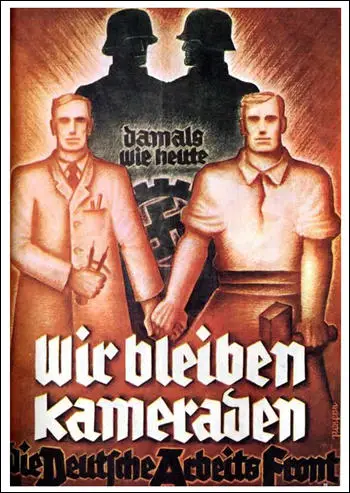
Strength Through Joy
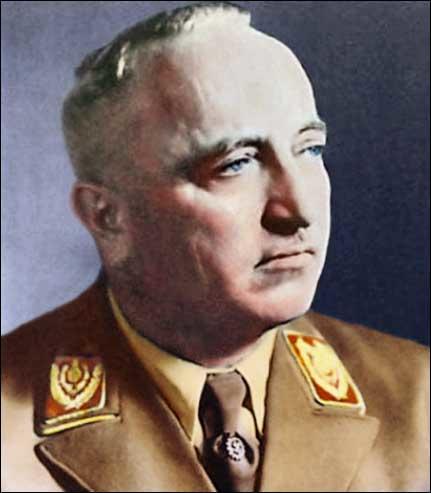
Workers in Nazi Germany
Robert Ley and Corruption
Volkswagen
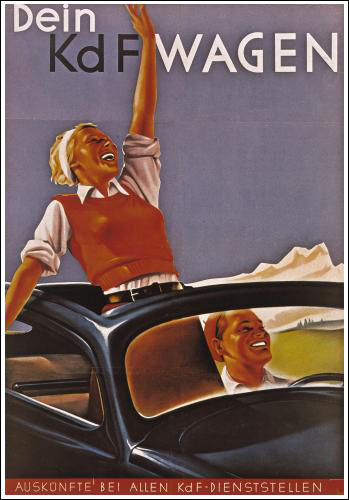
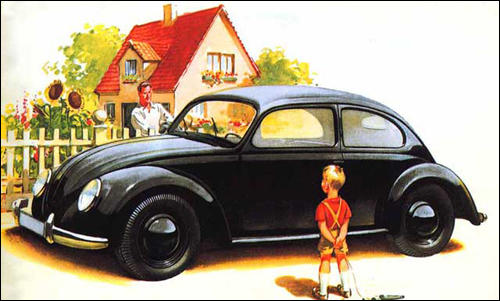
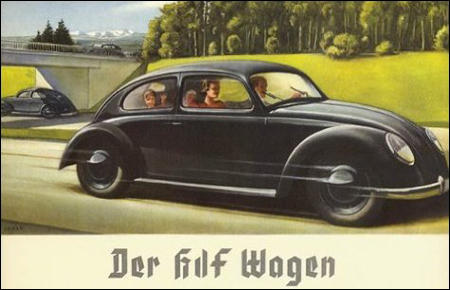
Private Life
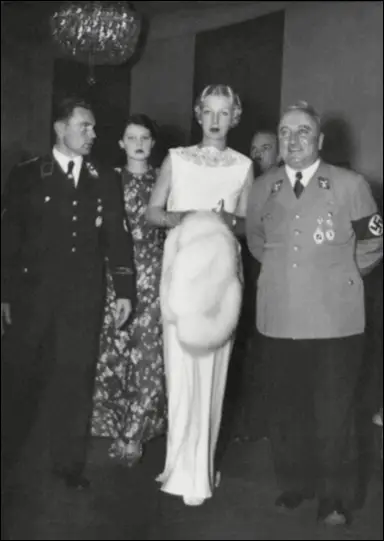
Second World War
Primary Sources
(1) Robert Ley, Social Policy in the New Germany (1938)
The trade unions that were swayed by Marxist teaching did not want social peace. They calculated that their chances of acquiring political power would improve with the growing dissatisfaction of the workers. One of the first necessities with which the Hitler Government found itself faced was that of dissolving the organizations that kept alive the antagonism between employers and employees. They were replaced by the Labour Front.
(2) Albert Speer had a meeting with Robert Ley in the autumn of 1944.
Robert Ley, by profession a chemist, took me along in his special railroad car to a meeting in Sonthofen held in the autumn of 1944. As usual, our conversation took place over glasses of strong wine. His increased stammering betrayed his agitation. "You know we have this new poison gas - I've heard about it. The Fuehrer must do it. He must use it. Now he has to do it!"
Hitler, to be sure, had always rejected gas warfare; but now he hinted at a situation conference in headquarters that the use of gas might stop the advance of Soviet troops. He went on with vague speculations that the West would accept gas warfare against the East because at this stage of the war the British and American governments had an interest in stopping the Russian advance. When no one at the situation conference spoke up in agreement, Hitler did not return to the subject.
(3) Fritz Thyssen, I Paid Hitler (1941)
In order to allay discontent, Hitler conceived of a new idea. Every German shall own his car. He asked industry to devise a popular car model to be built at such a low price that millions could buy it. The Volkswagen (People's Car) has been talked of for the past five years and has never been seen on the market. "These cars will be built for the new highways," said the party propagandists; "an entire family will be able to ride in one of them at 100 kilometers (60 miles) an hour." The party leaders say that the highways were built for the People's Car. But the People's Car is one of the most bizarre ideas the Nazis ever had. Germany is not the United states. Wages are low. Gasoline is expensive. German workers never dreamed of buying a car. They cannot afford the upkeep; to them it is a luxury.
Dr. Ley, the stammering drunkard who is the chief of the German Labor Front. He controls the four to five hundred million marks paid in every year by the German workers as dues to the Labor Front. I do not say that he puts all this money into his own pocket. But the figure has certainly turned his head.
He had an automobile factory built for the production of the People's Car. On this occasion he invented a brand new form of knavery. The future buyers of the People's Car were invited to buy it in advance, by making predelivery installments. This is the reverse of the credit installment system. The system shows genius. Ley pocketed about a hundred million marks when the war came because the People's Car factory now had to produce tanks and motorcycles for the army.
(4) Robert Ley, suicide note (24th October, 1945)
We have forsaken God, and therefore we were forsaken by God. We put human volition in the place of His godly grace. In anti-Semitism we violated a basic commandment of His creation. Anti-Semitism distorted our outlook, and we made grave errors. It is hard to admit mistakes, but the whole existence of our people is in question; we Nazis must have the courage to rid ourselves of anti-Semitism. We have to declare to the youth that it was a mistake.”
Student Activities
Hitler's Volkswagen (The People's Car) (Answer Commentary)
Adolf Hitler's Early Life (Answer Commentary)
The Assassination of Reinhard Heydrich (Answer Commentary)
Heinrich Himmler and the SS (Answer Commentary)
